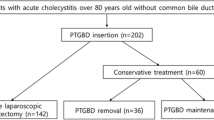Abstracts
Background
Open converted cholecystectomy could occur in patients who planned for laparoscopic cholecystectomy after endoscopic removal of choledocholithiasis.
Aim
To evaluate the risk factors associated with open converted cholecystectomy.
Patients and Methods
The data for all patients who underwent cholecystectomy after endoscopic removal of choledocholithiasis were retrospectively reviewed. Factors predictive for conversion to open cholecystectomy were analyzed.
Results
The rate of open converted cholecystectomy was 15.7 %. In multivariate analysis, cholecystitis (OR 1.908, 95 % CI 1.390–6.388, p = 0.005), mechanical lithotripsy (OR 6.129, 95 % CI 1.867–20.123, p < 0.005), and two or more choledocholithiases (OR 2.202, 95 % CI 1.097–4.420, p = 0.026) revealed significant risk factors for conversion to open cholecystectomy. Analyzing the risk factors for open converted cholecystectomy according to duration from endoscopic stone removal to cholecystectomy (within 2 weeks, between 2 and 6 weeks, and beyond 6 weeks), acute cholangitis (OR 3.374, 95 % CI 1.267–8.988, p = 0.015), cholecystitis (OR 3.127, 95 % CI 1.100–8.894, p = 0.033), and mechanical lithotripsy (OR 17.504, 95 % CI 3.548–86.355, p < 0.005) were related to open converted cholecystectomy in ≤2 weeks group.
Conclusions
For patients who need cholecystectomy after endoscopic removal of choledocholithiasis, endoscopic retrograde cholangiography-related factors predictive for open converted cholecystectomy are helpful in planning the appropriate timing of surgery.

Similar content being viewed by others
References
Joyce WP, Keane R, Burke GJ, et al. Identification of bile duct stones in patients undergoing laparoscopic cholecystectomy. Br J Surg. 1991;78:1174–1176.
Sarli L, Iusco DR, Roncoroni L. Preoperative endoscopic sphincterotomy and laparoscopic cholecystectomy for the management of cholecystocholedocholithiasis: 10-year experience. World J Surg. 2003;27:180–186.
Cuschieri A, Lezoche E, Morino M, et al. E.A.E.S. multicenter prospective randomized trial comparing two-stage vs single-stage management of patients with gallstone disease and ductal calculi. Surg Endosc. 1999;13:952–957.
Arregui ME, Davis CJ, Arkush AM, Nagan RF. Laparoscopic cholecystectomy combined with endoscopic sphincterotomy and stone extraction or laparoscopic choledochoscopy and electrohydraulic lithotripsy for management of cholelithiasis with choledocholithiasis. Surg Endosc. 1992;6:10–15.
Alimoglu O, Ozkan OV, Sahin M, Akcakaya A, Eryilmaz R, Bas G. Timing of cholecystectomy for acute biliary pancreatitis: outcomes of cholecystectomy on first admission and after recurrent biliary pancreatitis. World J Surg. 2003;27:256–259.
Boerma D, Rauws EA, Keulemans YC, et al. Wait-and-see policy or laparoscopic cholecystectomy after endoscopic sphincterotomy for bile-duct stones: a randomised trial. Lancet. 2002;360:761–765.
Prat F, Malak NA, Pelletier G, et al. Biliary symptoms and complications more than 8 years after endoscopic sphincterotomy for choledocholithiasis. Gastroenterology. 1996;110:894–899.
Hill J, Martin DF, Tweedle DE. Risks of leaving the gallbladder in situ after endoscopic sphincterotomy for bile duct stones. Br J Surg. 1991;78:554–557.
Lai KH, Lin LF, Lo GH, et al. Does cholecystectomy after endoscopic sphincterotomy prevent the recurrence of biliary complications? Gastrointest Endosc. 1999;49:483–487.
Chan AC, Chung SC, Wyman A, et al. Selective use of preoperative endoscopic retrograde cholangiopancreatography in laparoscopic cholecystectomy. Gastrointest Endosc. 1996;43:212–215.
ASGE Standards of Practice Committee, Anderson MA, Fisher L, Jain R, et al. Complications of ERCP. Gastrointest Endosc. 2012;75:467–473.
Freeman ML, Nelson DB, Sherman S, et al. Complications of endoscopic biliary sphincterotomy. N Engl J Med. 1996;335:909–918.
de Vries A, Donkervoort SC, van Geloven AA, Pierik EG. Conversion rate of laparoscopic cholecystectomy after endoscopic retrograde cholangiography in the treatment of choledocholithiasis: does the time interval matter? Surg Endosc. 2005;19:996–1001.
Eldar S, Eitan A, Bickel A, Sabo E, et al. The impact of patient delay and physician delay on the outcome of laparoscopic cholecystectomy for acute cholecystitis. Am J Surg. 1999;178:303–307.
Mathuna PM, White P, Clarke E, Merriman R, Lennon JR, Crowe J. Endoscopic balloon sphincteroplasty (papillary dilation) for bile duct stones: efficacy, safety, and follow-up in 100 patients. Gastrointest Endosc. 1995;42:468–474.
Schneider MU, Matek W, Bauer R, Domschke W. Mechanical lithotripsy of bile duct stones in 209 patients-effect of technical advances. Endoscopy. 1988;20:248–253.
Hochberger J, Tex S, Maiss J, Hahn EG. Management of difficult common bile duct stones. Gastrointest Endosc Clin N Am. 2003;13:623–634.
Stefanidis G, Viazis N, Pleskow D, et al. Large balloon dilation vs. mechanical lithotripsy for the management of large bile duct stones: a prospective randomized study. Am J Gastroenterol. 2011;106:278–285.
Lai PB, Kwong KH, Leung KL, et al. Randomized trial of early versus delayed laparoscopic cholecystectomy for acute cholecystitis. Br J Surg. 1998;85:764–767.
Lu J, Cheng Y, Xiong XZ, Lin YX, Wu SJ, Cheng NS. Two-stage vs single-stage management for concomitant gallstones and common bile duct stones. World J Gastroenterol. 2012;18:3156–3166.
Clayton ES, Connor S, Alexakis N, Leandros E. Meta-analysis of endoscopy and surgery versus surgery alone for common bile duct stones with the gallbladder in situ. Br J Surg. 2006;93:1185–1191.
Rogers SJ, Cello JP, Horn JK, et al. Prospective randomized trial of LC+LCBDE vs ERCP/S+LC for common bile duct stone disease. Arch Surg. 2010;145:28–33.
Liberman MA, Phillips EH, Carroll BJ, Fallas MJ, Rosenthal R, Hiatt J. Cost-effective management of complicated choledocholithiasis: laparoscopic transcystic duct exploration or endoscopic sphincterotomy. J Am Coll Surg. 1996;182:488–494.
Conflict of interest
Yong Hwan Kwon, Min Kyu Jung, Chang-Min Cho, Sang Gul Kim, Young Kook Yoon have no conflicts of interest or financial ties to disclose.
Author information
Authors and Affiliations
Corresponding author
Rights and permissions
About this article
Cite this article
Kwon, Y.H., Cho, CM., Jung, M.K. et al. Risk Factors of Open Converted Cholecystectomy for Cholelithiasis After Endoscopic Removal of Choledocholithiasis. Dig Dis Sci 60, 550–556 (2015). https://doi.org/10.1007/s10620-014-3337-6
Received:
Accepted:
Published:
Issue Date:
DOI: https://doi.org/10.1007/s10620-014-3337-6



